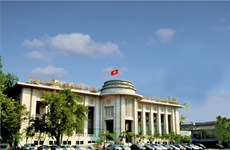UOB: Vietnam a silver lining in Asia amid trade tensions
 Experts of UOB at a seminar on Vietnam market economic research (Source: VietnamPlus)
Experts of UOB at a seminar on Vietnam market economic research (Source: VietnamPlus)Hanoi (VNA) – Vietnam is a silver lining in the Asian region amid trade tensions, according to the latest report from the United Overseas Bank Limited (UOB).
Vietnam is expected to see economic growth of 6.7 percent in 2019 and become one of the fastest growing economies in the world.
Robust domestic demand and increasing foreign direct investment (FDI) are expected to continue fuelling Vietnam’s economic growth this year, the report said.
The country’s inflation is forecast at around 3.4 percent for this year.
According to the report, the US-China trade tension which shows little signs of abating has been affecting global supply chains. The threat of high tariffs on Chinese imports has forced manufacturers to consider shifting their production to alternative locations in order to mitigate the impact from the trade tariffs.
ASEAN countries, particularly Vietnam and Malaysia, will be the most favoured destinations of investment relocation of multinational enterprises (MNEs), the report said.
Data showed that FDI inflows to Vietnam surged since the onset of US-China trade tension in the third quarter of 2018. Ending the year, FDI into Vietnam increased 9.1 percent year-on-year, reaching a record high of 19 billion USD.
The figure could exceed 20 billion USD this year with more new projects launched, the report forecast, showing in the first seven months, the number of new FDI projects in Vietnam increased 25 percent over the same period of last year to 2,064 projects.
Strategic location, competitive wages, young population and excellent network of trade agreements are strengths of Vietnam as an export production base which make it attractive for production relocation of foreign enterprises.
Manop Udomkerdmongkol, deputy director of global economics and market research at UOB Bank of Thailand, analysed that together with the growth of FDI inflows, new FDI projects underway in Vietnam are seeing steady signals.
The official explained that the increase in FDI was because some countries were concerned about the impact of the US-China trade war, so they moved factories to Vietnam and neighboring countries to minimize the infludence from trade tariffs.
In addition, labour costs in Vietnam are lower than those in other countries. The minimum wage for workers in Vietnam is 152 USD per month, China 330 USD, and Thailand 274 USD, he said.
Furthermore, Vietnam has a large workforce, while Singapore is in the period of aging population and Thailand will also face the same problem in the next six years, the official added.
In addition to the advantages of low labour and land costs that help attract businesses, Vietnam is also working towards sustainable development to improve the growth quality as well as the living standards of the people.
An important impetus is the Fourth Industrial Revolution, which will help improve the country’s labor productivity and enhance competitiveness to promote global value chains, he added.
In terms of the monetary policy, the UOB expected the State Bank of Vietnam (SBV) to maintain its stable policy with the refinancing rate of 6.25 percent throughout the year.
It forecast the USD/VND exchange rate will be higher at 23,400 VND in the third quarter and 23,600 VND in the last quarter of this year.
Vietnam’s economy expanded 7.1 percent in 2018, the fastest in the past 11 years. All the major sectors recorded growth, including manufacturing, construction, and wholesale and retail which rose 13 percent, 9.2 percent and 8.5 percent, respectively.
In the first half of this year, the economy grew 6.8 percent, driven by significant growth of exports and industrial production which was buoyed by increasing foreign investment in labour-intensive, export-oriented manufacturing and processing industries./.













